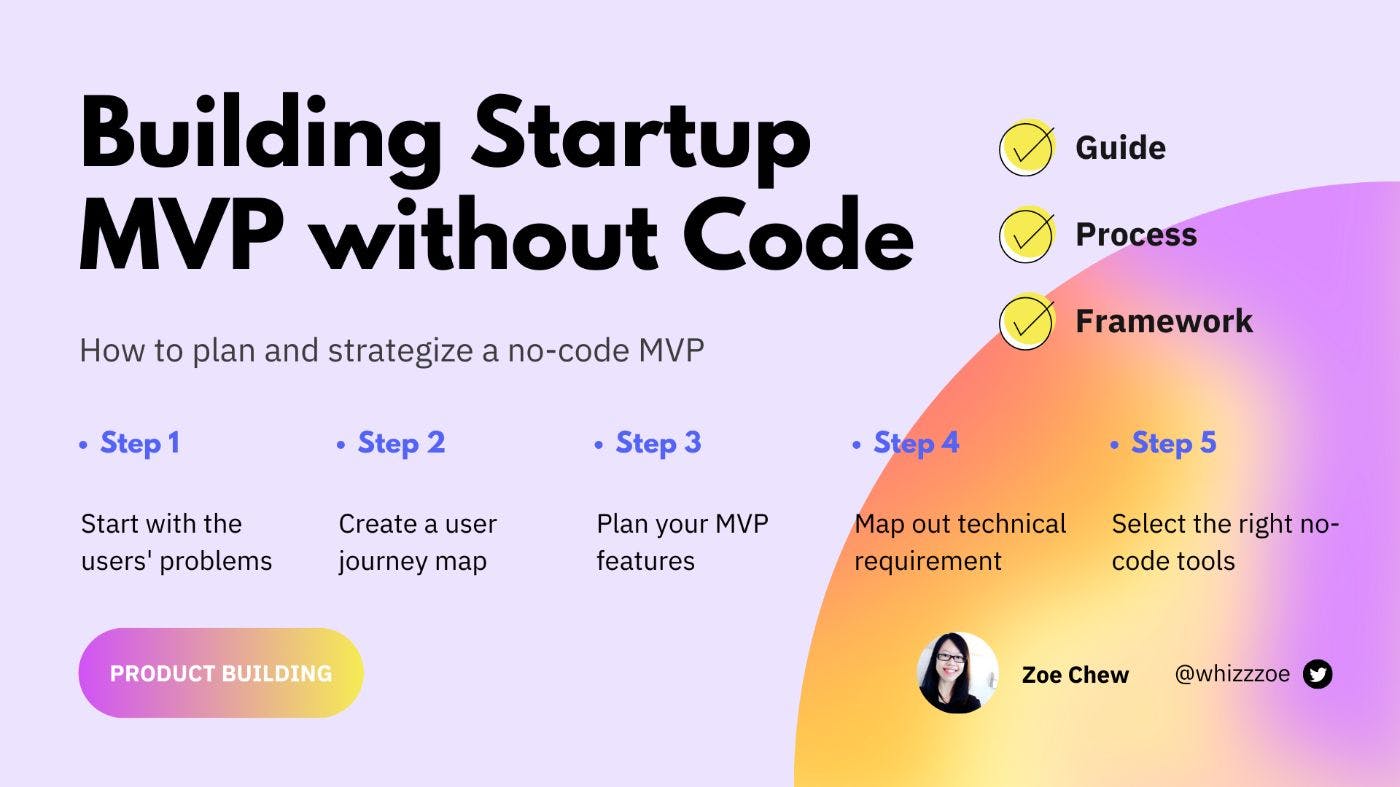Note: This article is part of my toolkit newsletters↗️ where I share resources about building things. Join me :)
As a product builder, I build things full-time, whether it’s a venture newsletter, micro-products or coaching founders to build tech products. For fun, I build AI article tool, event app, meal box app, SaaS tracker, sneaker app, using my rapid MVP technique.
Creating an MVP (minimum viable product) is a great way to test the viability of your startup idea and validate your assumptions before investing significant time and resources in building a full-fledged product.
In this post, I'll share my frameworks for no-code MVP. Join my newsletter as I continue to provide valuable product guide series like Validation, Product Goals and Product/Market Fit.
Step 1: Map out the users’ problems
Don’t start with no-code tools (solution), start with the users (problem).
Before you start thinking about no-code tools, figure out who has the problem by creating a user persona, what the users' problems are and how you can build something to meet their needs.
You can investigate users’ problems through these methods:
- Interview potential users to uncover their frustrations
- Research about customer’s pain points through existing channels (forums, reddit, communities, keyword research)
- Create a Typeform survey and solicit feedback from a focus group
- Analyze and document feedback from potential customers
Step 2: Map out the users’ journey
Once you have a clear understanding of your users' problems, the next step is to map out the users’ journey.
A user's journey represents the steps a user takes to achieve a specific goal and jobs to be done while interacting with your product.
One easy way to figure out the touch points of your user is to create a customer journey map:
There are four components in the user journey map. Let’s create a mapping for building a Ketogenic Recipe app.
Example: Users want to find keto recipes using an app
Stages: The stages of user path from point A to point B to point C.
- Hungry > Look up a recipe > Cook a meal
User tasks: Actions a user will take at point A, point B and point C.
- Search for keto-friendly recipes > Browse recipes > Prepare meals
Pain points: Problems facing a user at point A, point B and point C.
- Lack of varieties > Need to eliminate high-carbs foods > Limited recipe options
Opportunities: List of possible solutions to solve the pain points at different stages.
- Answer a simple quiz > Personalized search > Provide recipe recommendations
Step 3: Plan your MVP features
Make a list of key functionality for your MVP.
Brainstorm potential features that are critical to solving users’ pain points (in Step 2) in the most effective way.
Example: Key functionality of a keto recipe app
- User login to the app using Google auth
- Separate recipes based on different categories
- Create advanced search and filter for unique dietary needs
- A list of keto recipes with ingredient lists and cooking instructions
- Ability to bookmark or save recipes
How to keep your MVP lean:
It's important to keep in mind that your MVP should be as simple as possible. So that you can launch quickly, test your assumptions and validate your app idea with minimum resources.
Here’s my guiding principle:
- create a minimum set of features
- only include the essential features that are required to solve the user's problems
- solve one main problem (help users find keto recipes) and branch out later with wider scope (e.g. meal planner, community suggestions, personalize recipes)
Step 4: Map out the technical requirement
Based on the required MVP features, make a list of technical requirement that will help you in building the MVP functionality.
Example
- User management: Allow users to create an account, login, and access their saved recipes.
- Database: To display recipe item listing, upload recipe photo, description, ingredient lists, and tag food categories
- Filter and search: Allow users to select specific dietary needs and search recipes by keywords
This will help you determine what kinds of no-code tools to look for in the next step.
Step 5: Evaluate no-code tools
No-code tools are a great option for building MVPs because they allow you to create MVP features quickly and cheaply without any coding knowledge.
In the previous step, you can see that we're looking for no-code platforms that will allow us to build out the user management, database, CMS, and advanced filter features.
Therefore, when researching about no-code tools, you should look for tools that excel in these areas.
Criteria for choosing no-code tools
There’re other criteria to consider when choosing the right no-code tools. Let’s break it down:
- Is the use case suitable? Look at all the no-code sample apps. Does the no-code tool allow you to create the functionality you want in your MVP? Are you building a mobile app or web-based app?
- Does it allow me to integrate with other tools? Can they be seamlessly integrated with other tools to enable you to stitch different components together (payment, automation, online forms, email list) and create a sufficient solution for your users?
- How customizable is this tool? Consider each tool's limitations. Is it easy to use? What does it do well and what does it not? Do you need to evaluate other alternative tools?
- Feature expansion. If you want to build your MVP further, how flexible is the no-code platform to accommodate the growth and expansion of your MVP? What is the cost involved in adding new features and functionalities as your MVP evolves?
[1] Find me on Twitter / LinkedIn 🔥
[2] Get my product-building teardown — Join my newsletter 🚀
Also Published Here


